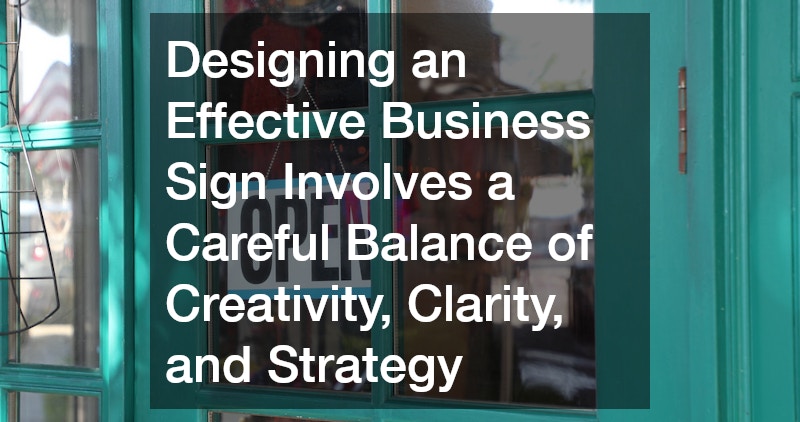A business sign is more than just a marker—it’s a silent salesperson that communicates your brand’s identity, values, and professionalism to everyone who passes by. Whether you’re a small startup or an established company, a well-designed sign can help you attract attention, build recognition, and drive customer engagement. To achieve these goals, understanding the principles of strong business design and how they apply to signage is essential.
Understand Your Brand Identity
Before diving into fonts, colors, or materials, the first step in creating an effective sign is defining your brand identity. Your business sign should reflect who you are and what you stand for. Think about your brand’s personality—whether it’s modern and sleek, traditional and elegant, or bold and playful.
These attributes should influence every design decision you make.
For example, a law firm might opt for a refined serif font and muted colors to convey professionalism, while a coffee shop may prefer hand-drawn lettering and warm tones that evoke comfort and creativity. Strong branding ensures your sign becomes an extension of your overall marketing strategy, building trust and consistency across all customer touchpoints.
Keep It Simple and Readable
When it comes to sign design, simplicity is key. Your audience has only a few seconds to read and understand your message as they pass by. Avoid overcrowding your sign with too much text or unnecessary graphics. Instead, focus on your business name, logo, and a brief tagline if needed.
Readability should be your top priority. Choose fonts that are easy to read from a distance, avoiding overly decorative styles that may appear cluttered or confusing. A general rule is that for every inch of letter height, the text should be readable from about 10 feet away. Contrasting colors—like dark text on a light background—also enhance visibility, especially outdoors or under varying lighting conditions.
Choose the Right Colors
Color plays a powerful role in visual communication. It can evoke emotions, attract attention, and strengthen brand recognition. When selecting colors for your sign, start with your brand palette, but also consider how different shades will appear in your specific environment.
For instance, a bright yellow or red can grab attention quickly, making them ideal for fast-food restaurants or retail promotions. Meanwhile, blues and greens often convey calmness and trust, suitable for healthcare, finance, or wellness businesses.
Balance is important—too many colors can overwhelm the eye. Stick to two or three main colors that complement each other. Also, consider the psychology of color: red suggests urgency or excitement, while black conveys sophistication and strength. Aligning your color choices with your business design principles ensures your signage communicates the right message.
Select High-Quality Materials
The visual appeal of your sign depends not only on design but also on material quality. The materials you choose affect durability, maintenance, and overall impression. Outdoor signs, for example, must withstand weather conditions such as rain, sunlight, and temperature changes.
Popular materials include aluminum, acrylic, PVC, wood, and metal composites. For illuminated or backlit signs, LED technology is energy-efficient and long-lasting. Working with a professional sign manufacturer can help you choose materials that best match your budget and business location. A high-quality sign not only looks better but also saves you money in the long run by reducing repair and replacement costs.
Consider Placement and Visibility
Even the most well-designed sign won’t achieve its purpose if it’s poorly placed. Consider where your sign will be viewed from—whether it’s pedestrians on a busy street, drivers passing by, or customers entering your building.
Height, angle, and distance all play crucial roles in visibility. Signs should be placed at eye level and free from obstructions like trees or other structures. Lighting also matters: well-lit signs remain visible after dark, ensuring your business continues to make an impression around the clock. For indoor signs, ensure they’re positioned in high-traffic areas where customers naturally look, such as entrances, reception areas, or display zones.
Balance Aesthetics with Function
An effective business sign combines beauty and practicality. While creative design elements make your sign visually appealing, it must also serve a clear function—communicating your message quickly and effectively.
Think about how different sign types serve different purposes. Monument signs make a bold statement outdoors, while window graphics can highlight promotions or business hours. Interior signs, like directional or lobby signs, enhance the customer experience by guiding visitors and reinforcing brand identity. Keeping functionality in mind ensures every element serves a purpose and contributes to your business goals.
Work with a Professional Designer
While DIY tools make it easier than ever to create designs, professional expertise can make a world of difference. A skilled designer understands the nuances of typography, proportion, and layout. They can help refine your concept, ensuring it meets both aesthetic and practical standards.
Collaborating with an experienced designer also ensures that your signage complies with local codes and size regulations. Professionals can provide mockups, suggest durable materials, and guide you through the production process, turning your ideas into a professional-grade finished product that stands out.
Test and Update Regularly
Finally, remember that effective signage isn’t static. Over time, design trends evolve, and your business might change its branding or offerings. Periodically review your signs to ensure they remain relevant and visually appealing.
If your sign’s colors have faded or your logo has changed, an update can breathe new life into your brand’s public image. Even small adjustments, such as better lighting or refreshed lettering, can significantly enhance visibility and customer perception.
Designing an effective business sign involves a careful balance of creativity, clarity, and strategy. From defining your brand identity to choosing the right colors, materials, and placement, each decision contributes to how your audience perceives your business. By focusing on strong business design principles and collaborating with professionals, you can create signage that not only captures attention but also reinforces your brand for years to come. A well-designed sign is more than decoration—it’s an investment in visibility, credibility, and long-term success.




